|
|
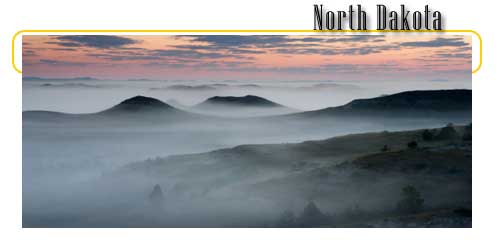
|
| |
North Dakota, North Dakota,
With thy prairies wide and free,
All thy sons and daughters love thee,
Fairest state from sea to sea;
North Dakota, North Dakota,
Here we pledge ourselves to thee.
North Dakota State Song
|
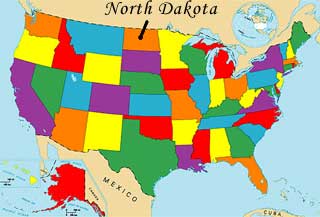 |

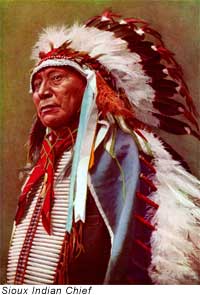 North Dakota and South Dakota are known as "twin states" because they were admitted to the Union on the same day, November 2, 1889. No one knows which state was admitted first because President Benjamin Harrison purposely shuffled and then blindly signed the papers. Alphabetically, North Dakota is recognized as the 39th state and South Dakota the 40th. However, the states aren't identical twins. They have similar shapes, sizes, and climates, but differ in many other ways. North Dakota and South Dakota are known as "twin states" because they were admitted to the Union on the same day, November 2, 1889. No one knows which state was admitted first because President Benjamin Harrison purposely shuffled and then blindly signed the papers. Alphabetically, North Dakota is recognized as the 39th state and South Dakota the 40th. However, the states aren't identical twins. They have similar shapes, sizes, and climates, but differ in many other ways.
Dakota is a Sioux Indian word for "friend" or "ally." One of the North Dakota's nicknames is the "Sioux State," which comes from the name of the original Native American settlers of the state's land. Today, about 20,000 Native Americans live there and make up the largest minority group in the state. North Dakota is also nicknamed the "Flickertail State" after the flickertail squirrels that are common in the central part of the state. The state's largest city is Fargo. The abbreviation for North Dakota is ND.

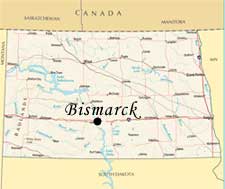 North Dakota is a West North Central state bordered by Canada to the north, Minnesota to the east, South Dakota to the south, and Montana to the west. The state's landscape includes the Red River Valley in the eastern part of the state and Badlands in the state's western region. Badlands are areas of small, steep hills and deep gullies formed primarily by water erosion. The state also has level prairies and rolling plains. Farms and ranches cover almost all of North Dakota's land. North Dakota is a West North Central state bordered by Canada to the north, Minnesota to the east, South Dakota to the south, and Montana to the west. The state's landscape includes the Red River Valley in the eastern part of the state and Badlands in the state's western region. Badlands are areas of small, steep hills and deep gullies formed primarily by water erosion. The state also has level prairies and rolling plains. Farms and ranches cover almost all of North Dakota's land.

North Dakota is dominated by agriculture. In fact, farming is more important to North Dakota's economy than any other state's economy, except South Dakota. North Dakota leads the nation in the production of sunflower seeds, flaxseed, and barley. The state is also a leading producer of oats, pinto beans, rye, and sugar beets. Only Kansas harvests more wheat than North Dakota.
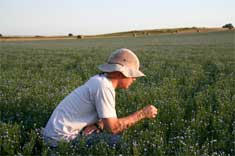 North Dakota has an above-average proportion of agricultural workers. Almost half of the state's residents live in rural areas. North Dakota's population has been declining after peaking in the 1930s. One of the reasons may be that modern farm technology has reduced the need for farm workers and many young people, especially highly trained and well-educated ones, have left the state. This has contributed to the fact that North Dakota ranks 47th in population, even though it ranks 17th in size. It is the least populous state in the Midwest. North Dakota has an above-average proportion of agricultural workers. Almost half of the state's residents live in rural areas. North Dakota's population has been declining after peaking in the 1930s. One of the reasons may be that modern farm technology has reduced the need for farm workers and many young people, especially highly trained and well-educated ones, have left the state. This has contributed to the fact that North Dakota ranks 47th in population, even though it ranks 17th in size. It is the least populous state in the Midwest.
North Dakota is more than just farms. The state's factories process agricultural products and equipment. North Dakota also has an abundance of natural resources. About two-thirds of the lignite coal in the United States can be found in the state. Although of inferior quality when compared with other coals, the state's lignite coal reserve is considered to be one of the world's greatest concentrations of solid fuel. The state also has large oil reserves. Petroleum is North Dakota's most valuable mineral resource.

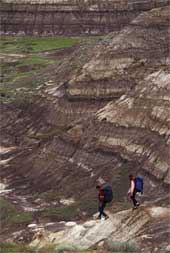 There are many reasons to visit North Dakota. See the annual United Tribes Powwow in Bismarck, the state's capital, in September. Visit the geographic center of North America. It's located just southwest of Rugby and is marked by a stone pile. Go to the International Peace Garden, a symbol of friendship between the United States and Canada. North Dakota is known as the "Peace Garden State." There are many reasons to visit North Dakota. See the annual United Tribes Powwow in Bismarck, the state's capital, in September. Visit the geographic center of North America. It's located just southwest of Rugby and is marked by a stone pile. Go to the International Peace Garden, a symbol of friendship between the United States and Canada. North Dakota is known as the "Peace Garden State."
|
|
 |
State Flag
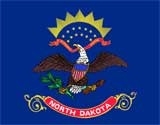
Capital...Bismarck
Largest City...Fargo
Population...642,200
Statehood...1889 (39th)
Area...ranked 48th
Motto...Liberty and Union, now and forever, one and inseparable
Nickname...Peace Garden State,
Roughrider State, Flickertail State
State Seal
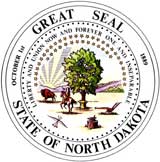
|
|
 |
|